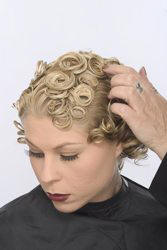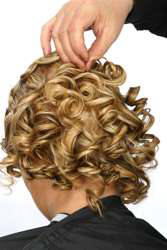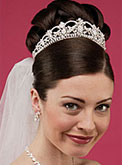 Bridal Hair Style and Hair Dos
Bridal Hair Style and Hair DosIn and about the other preparations for your wedding day, it may be tough to choose the perfect wedding "do," but a little careful planning will go a long way toward making sure your hair is beautiful on your happy day. When selecting a wedding hairstyle, some brides go for a dramatic, impressive up-do. Others choose to let their hair fall enhancing, naturally their style with subtle curls and waves. Whichever option suits you best, the tips and steps outlined below will help to make your hair shiny, strong, and lovely on the day of your wedding.

General Wedding Hair Opinion
Think about the season and climate in which your wedding will be taking place. Will the ceremony be indoors or outdoors? If your wedding is scheduled for a hot, humid time of year, think about an up-styled hairdo to help ward off frizz or limp locks.
 Start Wedding Haircare Beforehand
Start Wedding Haircare Beforehand
Depending upon the length of your hair, you should begin to think about your hairstyle three to six months in advance of your wedding. Are you thinking about dyeing your hair or getting a perm? Now's the time to experiment. The last thing you should want is to try a brand new color the week before your wedding and have it not work out, leaving you stuck with a shade of blond normally reserved for lemon sherbet. As you begin to consider your wedding day 'do, also think about your wedding dress and the style of veil you'll be wearing. A formal gown might pair well with an up-style, whereas a more casual dress may compliment a loose and flowing hairstyle. Think about your gown's neckline, as well, as this may help to determine which hairstyle will be right for the day of your marriage. During this time period, follow your normal hair care schedule, keeping your tresses healthy and clean.
 Wedding Hair Pre-Run
Wedding Hair Pre-RunIf you're having a stylist do your hair for your wedding day, be sure to schedule a "pre-run" about a month in advance of your marriage. If you know exactly what kind of approach you'd like to take, try to bring pictures from magazines as a reference for your hairstylist. Keep time in mind, as well - your run-through should not take more than an hour and a half, as you probably won't have more than this amount of time to set aside for hair on the day of your wedding. If you've picked one out, have your hairstylist practice with your veil or tiara. If you'll be doing your own styling, gather all the stuff and tools you'll need in a basket for easy storage, and try your hairstyle out! Use a well-lit room, preferably with a large vanity mirror. If you're going for an up-do, consider using hot curlers or rollers, just like Grandma did. Lightly blow dry your hair with the curlers still in. After you remove them, spritz with a bit of hairspray - just enough for your curls to hold their shape. Then, twist your hair up in your favorite style! The curls that rollers create will lend class and beauty to almost any up-do. And, remember that messy is in - it's ok if your wedding hair do isn't classically austere, as long as you think it's beautiful and you love the way it looks.
 Wedding Hair Coloring and Trim
Wedding Hair Coloring and TrimSchedule a hair appointment for about two weeks prior to your wedding day for a final trim and color touch up, if appropriate. About this time, you may also want to begin an intensive conditioning regimen, such that your hair will be healthy and full of shine on your wedding day.
Don't over-dry your hair the week before your wedding! Wash your hair every other day, and make sparing use of the blow dryer. If you've got some split ends, use a leave in conditioner on the days you wash your hair. If you're having your nails done, consider scheduling this appointment for the day before your wedding to save time.
 Your Wedding Day
Your Wedding DayUnless you're sure of your product, do not use conditioner the day of your wedding, as it will make your hair limp when it should be full-bodied. If you're doing your own hair, think about where you'll be doing it if it's not in the place that you practiced, will there be sufficient lighting, mirrors, and power outlets for all your tools and accessories? Consider adding a power strip and extension cord to your hair care basket, just in case. If you are working with a stylist, be sure he or she has accurate directions to wherever they will be doing your hair. If a team of hairstylists is working with your bridal party, be sure you clearly communicate exactly how many people's hair they will be doing and how much time they'll have to do the 'dos. Rather than assuming that a stylist will be able to fit one extra person in, check with them beforehand - they may be able to show up a half-hour earlier, saving everyone from a hectic race to beat the clock. Whether you are going for an up-do or a down-do, doing it yourself or working with a hairstylist, planning in advance will help to make sure your wedding hair looks as it should - absolutely you and absolutely beautiful.
 ______
______ 
 ______
______
 ______
______











































